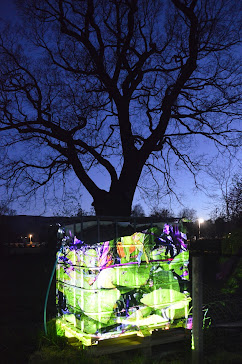Whilst the four Aftermath drawings made it out of the country to be shown in Finland (see previous post), Covid 19 and lockdown prevented planned artist visits and exchanges taking place. Thanks to Arts Council Wales Stabilisation Funds, I was able to extend the opportunity by making companion pieces to the Aftermath series and connecting with Marja Bonada, (artist and co-curator of the exhibition). Creative digital collaboration, exploration of the exhibition themes and sharing of mutual responses informed our respective artworks and practices. All the works seen here are my own. For Marja’s work see
@marjabonada and see the
a-n blog for an account of our exchanges.
I started by developing a new series of 12 drawings, keeping the 7'x2'6" format of Aftermath and the free flowing exchange between concrete and imagined forms. As a child, I was given an 1824 Clark's Myriorama: 16 interchangeable paintings of picturesque landscape that can be rearranged to create a near-endless variety of cohesive scenes.
Myrioramas became a popular entertainment and means of learning, just as tourism was developing and as ideas of picturesque and sublime were being challenged by profound changes due to industrial and agricultural revolution. The Myriorama still felt relevant to me as a way of re-interpreting landscape and its social context, bringing sites and objects into new relationship and offering new perspectives. The interchangeability of panels disrupts linear expectations and allows varying narratives of sense of place, extending conversations about beauty, value, risk, damage and loss, unexpected impacts of human activity, resilience and reparation.
Working in partnership brings a difference in energy, creating cross-currents and disturbance: digital exchanges with Marja opened up new ideas and explorations. I found myself experimenting with decayed buckets and a boiler found on spoil tips in the Black Mountains, which seemed to fit well with the Finland exhibition themes of of moderation, co-operation and equality, especially given that water - access and quality - is another looming global crisis. It also links in to some of my previous work about flood - and the hope that sustainable water management, like community based micro-hydro schemes, could be one of the answers to the challenge of what happens after capitalism.
During a gap in their exhibitions programme Oriel Davies Gallery, Newtown, Wales, let us use their gallery spaces for 3 days in October 2020, to experiment and develop work together. It was an amazing opportunity to be playful as well as ambitious, and to find out how we - and our works - would relate in a shared space. The principles of co-operation, moderation and equality were tested in practice, and were embodied in the generous welcome and support given by Oriel Davies.
Only two panels of the Myriorama could be seen at any one time in my studio, so at last I was able to hang my 12 Connectives and to rework them in relation to each other, then experiment with the sculptural elements of the found objects in relation to the drawings. Lastly I played with adding projection of roiling water from the locality of the historic Clydach ironworks contrasted with sequences of produce grown on our local allotments.
Marja and I found we'd both been strongly influenced through our lives by mythology and that it seeps through our work like a refrain - constant but constantly changing. We saw resonances and differences between our works: earth/air, light/dark, cacophony/harmony, memory/forgetting, risk/playfulness: maybe even beauty and terror. Although not explicitly about Covid 19, our project could not help being heavily influenced and affected by it. Along with most other people, we were never sure whether our plans could go ahead, and needed to be extra flexible and responsive to changing situations. We have felt more vulnerable in so many ways and find the principles of co-operation, moderation and equality more important and relevant than ever for us, the art world, society and the environment.






















